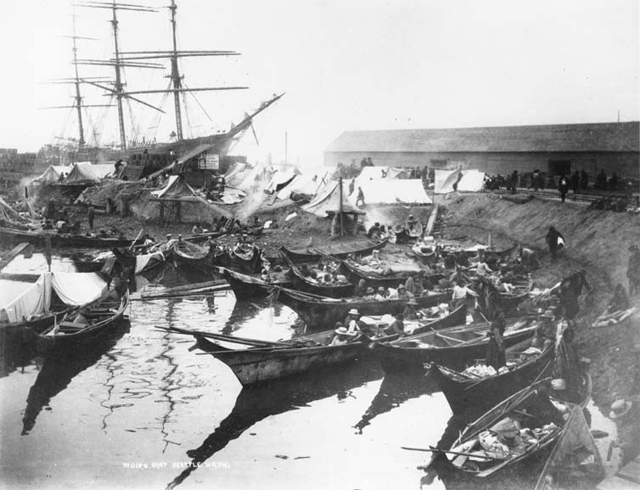
Ballast Island Historical Marker - Seattle, WA
N 47° 36.035 W 122° 20.168
10T E 549902 N 5272121
This historical monument and anchor lie along Alaskan Way and near a historic pergola along the waterfront in downtown Seattle, WA.
Waymark Code: WMG5Z7
Location: Washington, United States
Date Posted: 01/17/2013
Views: 6

Visitors walking along Alaskan Way, part of the Seattle waterfront, might notice an unobtrusive historical marker attached to an anchor and mounted on a square, concrete base. This anchor and historical monument are located near a very historic pergola that was once used as a boat launch for passengers ferrying in and around Puget Sound. This particular anchor has a metal plaque with an inscription that says the following:
HISTORICAL POINT OF INTEREST
BALLAST ISLAND
IN THIS AREA, ONCE PART OF THE BAY, VESSELS FROM PORTS ALL OVER THE WORLD DUMPED THEIR BALLAST. UNTOLD THOUSANDS OF TONS WERE UNLOADED INTO THE WATER BY SHIP'S CREWS, INCLUDING 40,000 TONS FROM SAN FRANCISCO'S TELEGRAPH HILL.
THE ISLAND, LONG A GATHERING PLACE FOR INDIANS ON THEIR ANNUAL MIGRATIONS, WAS COVERED IN THE 1890'S BY CONSTRUCTION OF RAILROAD AVENUE (NOW CALLED ALASKAN WAY).
PRESENTED BY
THE YUKON CLUB AND PROPELLER CLUB
In researching the history behind Ballast Island I discovered that this place was a sad, desolate place for Native Americans (called the Duwamish) who were forced to live here temporarily in the late 1800s, since the City of Seattle would not allow them to live in the city. There is a great historical account of the natives' exile to Ballast Island here and says:
The exile to Ballast Island
"Ballast Island" was created when sailing ships dumped their ballast of boulders and other materials at the City of Seattle's waterfront before taking on cargoes of lumber, grains, or other goods destined for San Francisco and other ports ... Duwamish families and other Native Americans came by canoe to the Seattle waterfront. Some were seasonal visitors, seeking work. Native Americans harvested and sold shellfish, and sold woven baskets and carvings, catering to the Whites' demand for souvenirs. Some were traveling to harvest the hopfields upriver. For some Duwamish, Ballast Island became a year-round residence by 1885 ... The Duwamish had been forced from their Longhouses in the new city of Seattle and other parts of their homeland. The United States Army and other Whites burned the Longhouses to prevent the Duwamish from returning to their traditional homeland ... Many Duwamish people did not want to relocate to live with traditional enemies at reservations built far from their ancestral villages and burial grounds. For several years, they were allowed to live on the bleak parcel of land, devoid of fresh water and other vital resources. Over time, the Duwamish adopted the use of canvas tents to replace their traditional cattail mat shelters ... In time, even Ballast Island became too valuable to the Whites and the Duwamish were exiled once again. By 1917, at the beginning of World War One, Native Americans living on Ballast Island was a distant memory.
I found another website here that gives a historical account of Ballast Island and highlights the island's origins:
Stories of the so-called island's origins conflict. By one telling, captains were ordered to unload here the broken rocks and bricks they carried to give stability to otherwise empty ships. By another account, pioneer wharf owners John Webster and Robert Knipe asked that the ballast be dropped to the side of their pier to protect the piles from wood-eating worms. Whichever, a modern core sample taken near the plaque would bring up a cosmopolitan mix of rubble from San Francisco, the Hawaiian Islands, Australia and many other ports.
Currently, Ballast Island is blocked off from any public access due to parts of the island and nearby pier being too dangerous to travel on. There is also road construction going on and the island is temporarily being used to hold equipment used in the construction/rehabilitation of this part of the waterfront.
***NOTE*** This monument as well as others along this stretch of waterfront along Alaskan Way have had access to them temporarily blocked by fencing due to construction projects. I had to jump a fence to get access to this monument and others on this stretch of walkway. I don't know when construction will end but I wanted you to know this in the event you try to visit these monuments. I encourage visitors to this area to let me know when the fencing comes down and I'll remove this disclaimer. Thanks